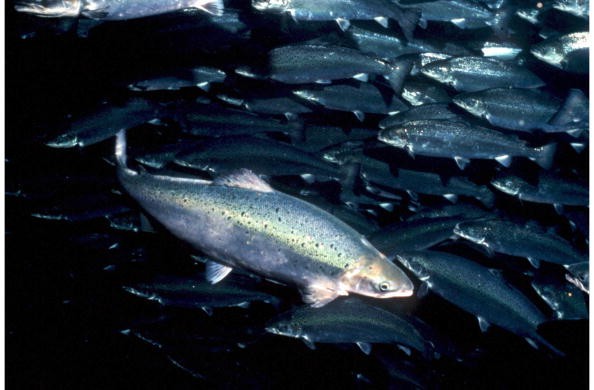According to UC Santa Barbara marine ecologist Ben Halpern, director of UCSB's National Center for Ecological Analysis & Synthesis and author of a paper published in the journal Current Biology, Salmon and Chicken environmental footprints are surprisingly similar due to how we farm these two popular proteins.
In an effort to elicit opportunities for reducing the significant environmental pressures associated with global food production, Halpern and an international team of colleagues examined how two highly popular animals are raised for consumption, with a particular focus on dynamics between land and sea.
Chicken And Farmed Salmon Have Remarkably Similar Environmental Footprints
 (Photo : TERJE MAROY/AFP via Getty Images)
(Photo : TERJE MAROY/AFP via Getty Images)

The researchers discovered that 95% of the total environmental footprint of these two products (greenhouse gas emissions, nutrient pollution, freshwater use, and spatial disturbance) is concentrated on less than 5% of the planet, with 85.5% spatial overlap between the two products, owing primarily to shared feed ingredients, as per ScienceDaily.
The total cumulative pressures from chicken production are highest in the United States, China, and Brazil, according to the study.
The greatest cumulative pressures for fish are found off the coasts of Chile, Mexico, and China, with some pressure on land from salmon aquaculture.
Furthermore, the researchers discovered that while farmed salmon has nine times the environmental footprint of chicken, it produces 55 times more than salmon, owing largely to the very fast reproductive cycle of chickens - six to eight weeks to reach slaughter weight versus one to two years for salmon.
There are differences in the environmental efficiencies of farming methods within the 5% of the planet that bears the environmental pressures of chicken and salmon production.
In the case of chicken, for example, the United States (the world's largest producer) and Brazil (the world's second-largest) are more efficient than China.
There are also regional differences in environmental pressures relative to the amount of salmon produced, indicating opportunities to improve efficiencies while minimizing environmental impacts.
Chicken and salmon are two of the most popular protein sources, and according to the researchers, they are more environmentally friendly than other animal protein sources like beef and pork.
However, the magnitude of their production, as well as their overlap in terms of environmental footprint, raises intriguing questions about the subtle connections between marine and land protein production, which could provide opportunities for promoting sustainability.
At the same time, the researchers emphasize the importance of integrating food policies across realms and sectors to advance food system sustainability.
Also Read: Salmon Discovered to Posses Natural Version of Night Vision Goggles, New Study Shows
How Do Farmed Salmon Affect Co2 Emissions?
SINTEF Fiskeri og havbruk, the Norwegian University of Science and Technology (NTNU), and Institutet för Livsmedel och Bioteknik (now SP Food and Bioscience) conducted a carbon footprint analysis of 22 Norwegian seafood products in 2009, as per Salmon Facts.
A carbon footprint includes both direct and indirect greenhouse gas emissions from manufacturing.
The products were thoroughly researched all the way to the wholesaler.
According to the study, one kilogram of farmed salmon fillet consumed in Paris has a CO2 equivalent (a unit used to compare CO2 emissions) of around 2.5.
Salmon farming has a much lower carbon footprint than cattle farming, which emits 30 CO2 equivalents per kilogram. 1 kilogram of pork produces approximately 5.9 kilograms of CO2.
The production of fish feed accounts for the majority of the CO2 emissions associated with salmon farming.
SINTEF has previously conducted life-cycle analyses of a variety of Norwegian seafood products on behalf of the authorities.
According to the findings, seafood based on the Norwegian aquaculture industry emits significantly less greenhouse gas than other meat production (such as chicken, pork and beef).
The climate cost of Norwegian fisheries and aquaculture, including fuel, aquaculture feed resources, processing, and transport to markets, is estimated to be 9.3 million tons of CO2 equivalents.
This is a large number, but it corresponds to the production of 3.1 million tons of seafood.
Related article: First Time Sighting: Endangered Fish Coho Salmon Found Following Revitalization Efforts in Mill Creek, California
© 2024 NatureWorldNews.com All rights reserved. Do not reproduce without permission.

![Tsunami Hazard Zones: New US Map Shows Places at Risk of Flooding and Tsunamis Amid Rising Sea Levels [NOAA]](https://1471793142.rsc.cdn77.org/data/thumbs/full/70325/280/157/50/40/tsunami-hazard-zones-new-us-map-shows-places-at-risk-of-flooding-and-tsunamis-amid-rising-sea-levels-noaa.jpg)



